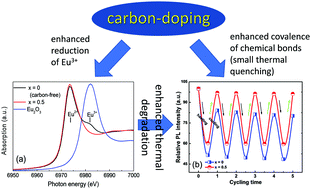当前位置:
X-MOL 学术
›
J. Mater. Chem. C
›
论文详情
Our official English website, www.x-mol.net, welcomes your
feedback! (Note: you will need to create a separate account there.)
Structural evolutions and significantly reduced thermal degradation of red-emitting Sr2Si5N8:Eu2+via carbon doping
Journal of Materials Chemistry C ( IF 5.7 ) Pub Date : 2017-07-17 00:00:00 , DOI: 10.1039/c7tc02908j Lihong Liu 1, 2, 3, 4, 5 , Le Wang 1, 2, 3, 4, 6 , Yuanqiang Li 7, 8, 9 , Chenning Zhang 10, 11, 12, 13, 14 , Yujin Cho 12, 13, 14, 15, 16 , Siu Wing Or 6, 17, 18, 19 , Tianliang Zhou 4, 20, 21, 22 , Takashi Takeda 5, 12, 13, 14 , Naoto Hirosaki 5, 12, 13, 14 , Rong-Jun Xie 5, 12, 13, 14, 20
Journal of Materials Chemistry C ( IF 5.7 ) Pub Date : 2017-07-17 00:00:00 , DOI: 10.1039/c7tc02908j Lihong Liu 1, 2, 3, 4, 5 , Le Wang 1, 2, 3, 4, 6 , Yuanqiang Li 7, 8, 9 , Chenning Zhang 10, 11, 12, 13, 14 , Yujin Cho 12, 13, 14, 15, 16 , Siu Wing Or 6, 17, 18, 19 , Tianliang Zhou 4, 20, 21, 22 , Takashi Takeda 5, 12, 13, 14 , Naoto Hirosaki 5, 12, 13, 14 , Rong-Jun Xie 5, 12, 13, 14, 20
Affiliation

|
A red-emitting nitridosilicate phosphor, Sr2Si5N8:Eu2+, shows very promising photoluminescence properties but exhibits serious thermal degradation, thus making it difficult to be used practically as a color converter in white light-emitting diodes (wLEDs). To alleviate this problem, we introduce carbon into the Sr2Si5N8 lattice to form thermally robust carbidonitride phosphors (Sr2Si5CxN8−4x/3:Eu2+). The carbon doping, evidenced by a variety of analytical techniques, leads to structural evolutions including lattice shrinkage, shortening of the average bond length of Eu–(C,N), and the removal of Eu3+ ions from the lattice. The photoluminescence intensity and quantum efficiency of phosphors are greatly improved by the carbon doping and reach the maximum at x = 0.5, dominantly owing to the enhanced absorption of Eu2+. Thanks to the increased oxidation resistance of Eu2+ due to the stronger covalency of Si–(C,N) and Sr(Eu)–(C,N) bonds, thermal degradation is significantly reduced from 16 to 0.8% when the carbon doping increases from x = 0 to 1.25. In addition, thermal quenching is also reduced by 10% at 300 °C and the quantum efficiency declines slowly with increasing temperature when carbon is substituted for nitrogen. At 300 °C, the internal quantum efficiencies are 55% and 62% for x = 0 and 0.5, respectively. The enhanced thermal stability of the carbon-doped sample is also confirmed by smaller variations in the luminous efficacy and color coordinates of monochromatic red LEDs.
中文翻译:

通过碳掺杂使发红光的Sr 2 Si 5 N 8:Eu 2+的结构演变和显着降低的热降解
发出红色光的亚硝酸硅磷光体Sr 2 Si 5 N 8:Eu 2+,显示出非常有希望的光致发光性能,但表现出严重的热降解,因此很难在白光发光二极管(wLED)中用作彩色转换器。为缓解此问题,我们将碳引入Sr 2 Si 5 N 8晶格中,以形成具有热稳定性的碳氮化物磷光体(Sr 2 Si 5 C x N 8−4 x / 3:Eu 2+)。碳的掺杂通过多种分析技术得到证明,导致结构演变,包括晶格收缩,Eu–(C,N)的平均键长缩短以及从晶格中去除Eu 3+离子。碳掺杂极大地提高了磷光体的光致发光强度和量子效率,并在x = 0.5时达到最大值,这主要是由于Eu 2+的吸收增强。由于Si–(C,N)和Sr(Eu)–(C,N)键的共价性较强,Eu 2+的抗氧化性增强,当碳掺杂时,热降解从16%显着降低至0.8%从x增加= 0至1.25。此外,在用碳代替氮时,在300°C时热淬灭也降低了10%,并且量子效率随着温度的升高而缓慢下降。在300°C下,对于x = 0和0.5,内部量子效率分别为55%和62%。碳掺杂样品的增强的热稳定性还通过单色红色LED的发光效率和色坐标的较小变化来确认。
更新日期:2017-09-14
中文翻译:

通过碳掺杂使发红光的Sr 2 Si 5 N 8:Eu 2+的结构演变和显着降低的热降解
发出红色光的亚硝酸硅磷光体Sr 2 Si 5 N 8:Eu 2+,显示出非常有希望的光致发光性能,但表现出严重的热降解,因此很难在白光发光二极管(wLED)中用作彩色转换器。为缓解此问题,我们将碳引入Sr 2 Si 5 N 8晶格中,以形成具有热稳定性的碳氮化物磷光体(Sr 2 Si 5 C x N 8−4 x / 3:Eu 2+)。碳的掺杂通过多种分析技术得到证明,导致结构演变,包括晶格收缩,Eu–(C,N)的平均键长缩短以及从晶格中去除Eu 3+离子。碳掺杂极大地提高了磷光体的光致发光强度和量子效率,并在x = 0.5时达到最大值,这主要是由于Eu 2+的吸收增强。由于Si–(C,N)和Sr(Eu)–(C,N)键的共价性较强,Eu 2+的抗氧化性增强,当碳掺杂时,热降解从16%显着降低至0.8%从x增加= 0至1.25。此外,在用碳代替氮时,在300°C时热淬灭也降低了10%,并且量子效率随着温度的升高而缓慢下降。在300°C下,对于x = 0和0.5,内部量子效率分别为55%和62%。碳掺杂样品的增强的热稳定性还通过单色红色LED的发光效率和色坐标的较小变化来确认。











































 京公网安备 11010802027423号
京公网安备 11010802027423号